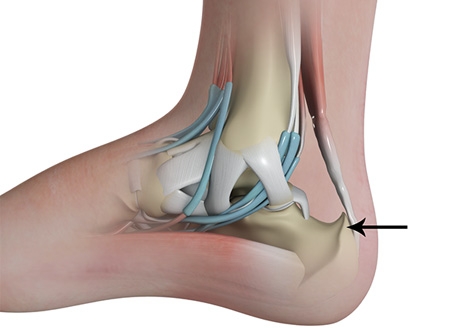'Tis the season for elective procedures! This sentiment rings particularly loudly in the world of orthopedics. Above and beyond the traditional joint replacement procedures, we offer more intricate elective surgeries in the extremities of the body, which are also popular once the deductibles are hit. One of those surgeries addresses a Haglund’s Deformity. Never heard of it? Read on to find out!
A Haglund’s deformity is a bony protrusion that forms on the back of the heel, or calcaneus bone, in the foot. This bony growth typically develops because of relentless friction occurring in that region usually caused by ill-fitting shoes. This deformity is often referred to as a 'pump bump' because the pump-style high heels worn by women are frequently the culprit of its development. Some non-footwear related factors have been found to contribute to the formation of a Haglund’s Deformity as well such as walking on the outside aspect of the foot, having a high, rigid arch in the foot, or having a tight Achilles tendon.
The problem with the formation of this bone is that, once present, the prominence rubs on the soft tissues, namely the Achilles tendon and underlying bursa. This irritation is painful and causes inflammation of the tendon or bursa, or Achilles tendinitis or bursitis respectively. Such irritation can also increase the risk of the tendon rupturing if exposed to trauma that forces the toes toward the shin. These symptoms are what bring patients limping into our office as most people are not concerned about a ‘cosmetic deformity’ present on their foot. Rather, it is the pain they experience with walking that prompts a phone call to their trusted orthopedic specialist.
Treatment options for a Haglund’s deformity is most often conservative in nature to include properly-fitting foot attire, daily and diligent heel cord stretching, heel pads to provide a protective barrier, and anti-inflammatory medications to alleviate the irritation of the tendon or bursa. Oftentimes, these measures are sufficient in managing the discomfort associated with this pathology. In particularly stubborn cases, sometimes a pneumatic walking boot is prescribed to further minimize stress on the already irritated tendon. Sometimes this recommendation is coupled with a course of formal physical therapy where patients get individualized attention,passive stretching, and modalities such as ultrasound, iontophoresis, and soft tissue mobilization that cannot be done with a home exercise program. The goal of these treatment measures is not to eliminate the bony outgrowth, but rather to alleviate the symptoms it is causing.
In only the most unrelenting cases is surgical removal of the Haglund’s deformity recommended. In very rare cases where the surrounding area is free of calcium deposits can the Achilles tendon simply be moved to gain access to the Haglund’s deformity for removal. Most often, the tendon has to be cut and subsequently repaired to gain access to the bone in order to remove it. It is the repair of the Achilles tendon that lengthens the timeline of recovery and mandates a period of immobilization. Patients should anticipate a period of time in a pneumatic walking boot with a non weight bearing status at the bare minimum. Post-operative treatment will vary depending on the surgeon and extent of the procedure.
If you have been struggling with unrelenting heel pain despite the usual home remedies, call our office to schedule a consultation with Dr. Viehe or Dr. Zhu today!
This blog is written by one of our very own-Morgan. She is a certified athletic trainer working in our clinic with our providers each and every day. She obtained a bachelor's degree in athletic training from Carroll University in Waukesha and a master's degree in Kinesiology from Michigan State University.

